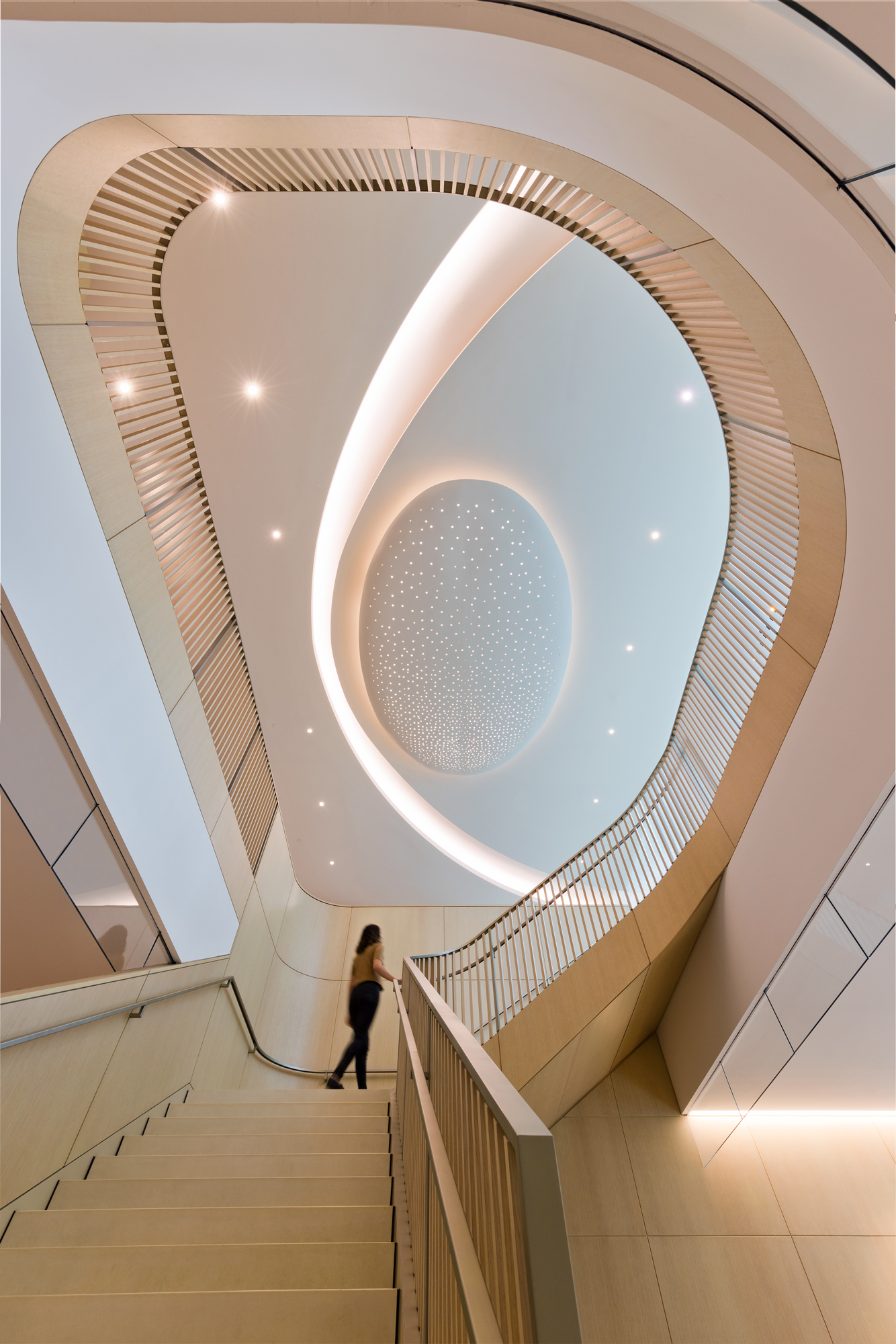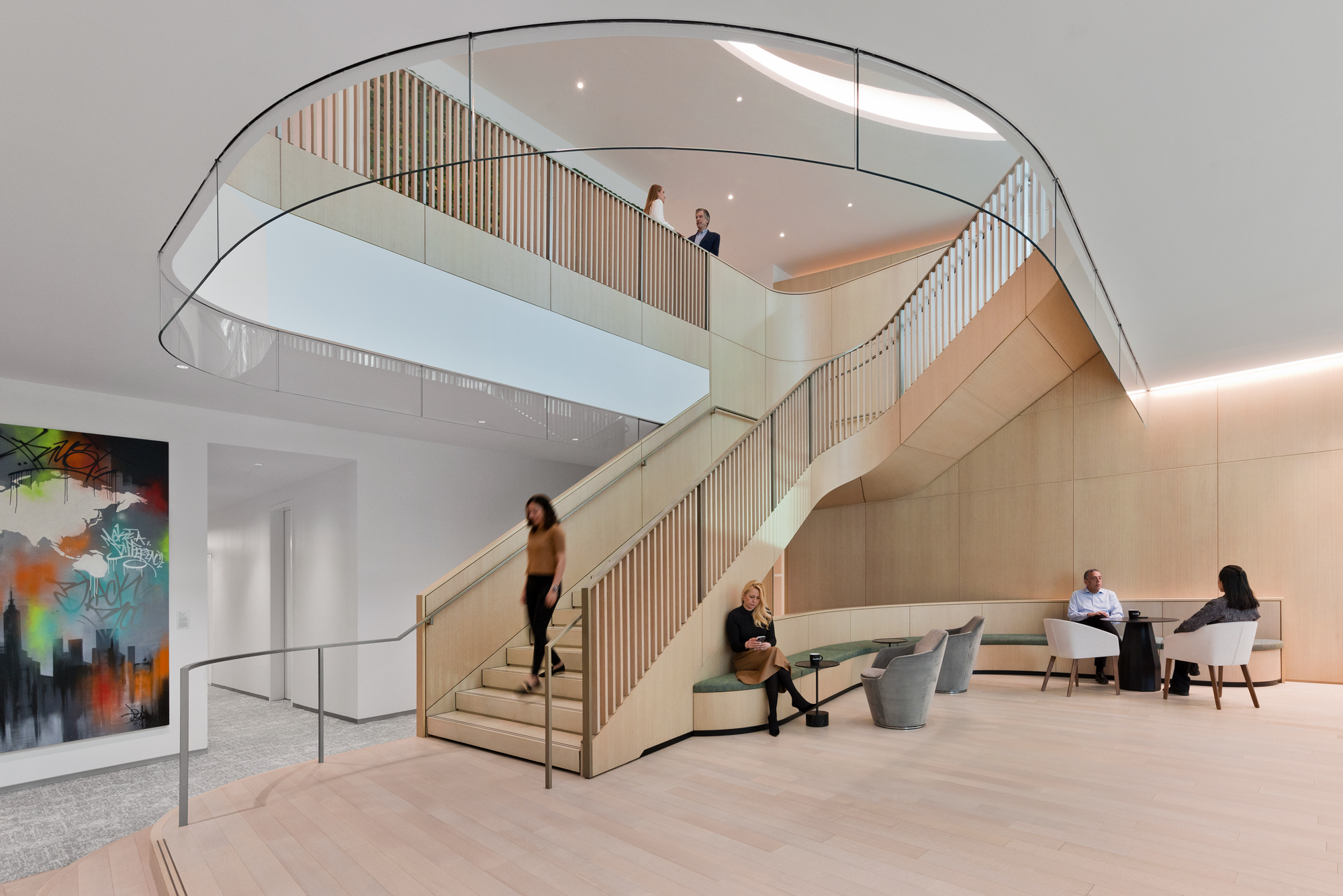THE PHYSICS OF TUNABLE WHITE
Color Space
This image is what’s known as a color space. It is a representation of all possible visible colors of light. This particular space is the x,y space. Other color spaces serve different purposes. Each point within the color space has a set of coordinates describing its location within the space, known as its chromaticity coordinates. These coordinates identify the exact color of light and result from a spectrophotometer, among other tools.
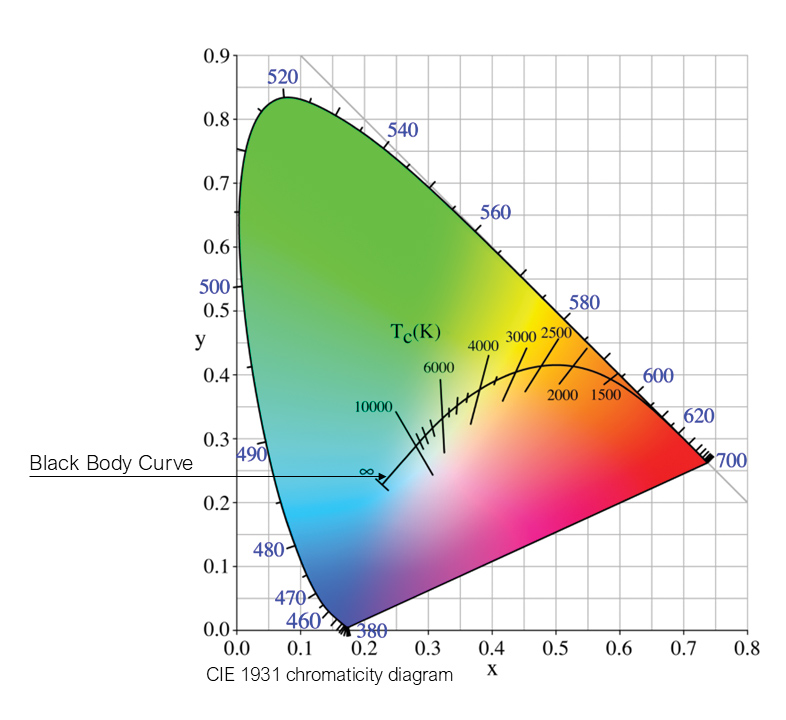
Image courtesy of Lutron Electronics Co., Inc.
Color space represents all possible colors of light.
The boundary of color space is defined by monochromatic light, a single wavelength of light, and everything inside from the edge is a mix of wavelengths. The axis, x, and y, are unitless and represent relative amounts of light: x being the relative amount of red light, and y being the relative amount of green light.
As discussed earlier, the curve highlighted in the middle is the black body curve or black body locus. It represents all of the possible white lights along the range of color temperatures. Along this curve are the commonly used CCTs.
MacAdam Ellipse
Many light source spec sheets refer to color difference or SDCM (Standard Deviations of Color Matching) or MacAdam ellipses. The SDCM indicates the likelihood that someone would notice a difference between a light source with a given set of x,y values and a comparison light source with another set of x,y values.
This color-matching deviation is an important concept when specifying a project’s lighting. Sometimes, a manufacturer may say their LEDs are within a two-step MacAdam ellipse. This means that 95% (two standard deviations) would notice a difference between the center of the ellipse and the boundary of the ellipse between those two points. In this drawing, the ellipses are scaled up to be able to see them. They are 10 times the size they would normally be for a 1-step MacAdam ellipse.
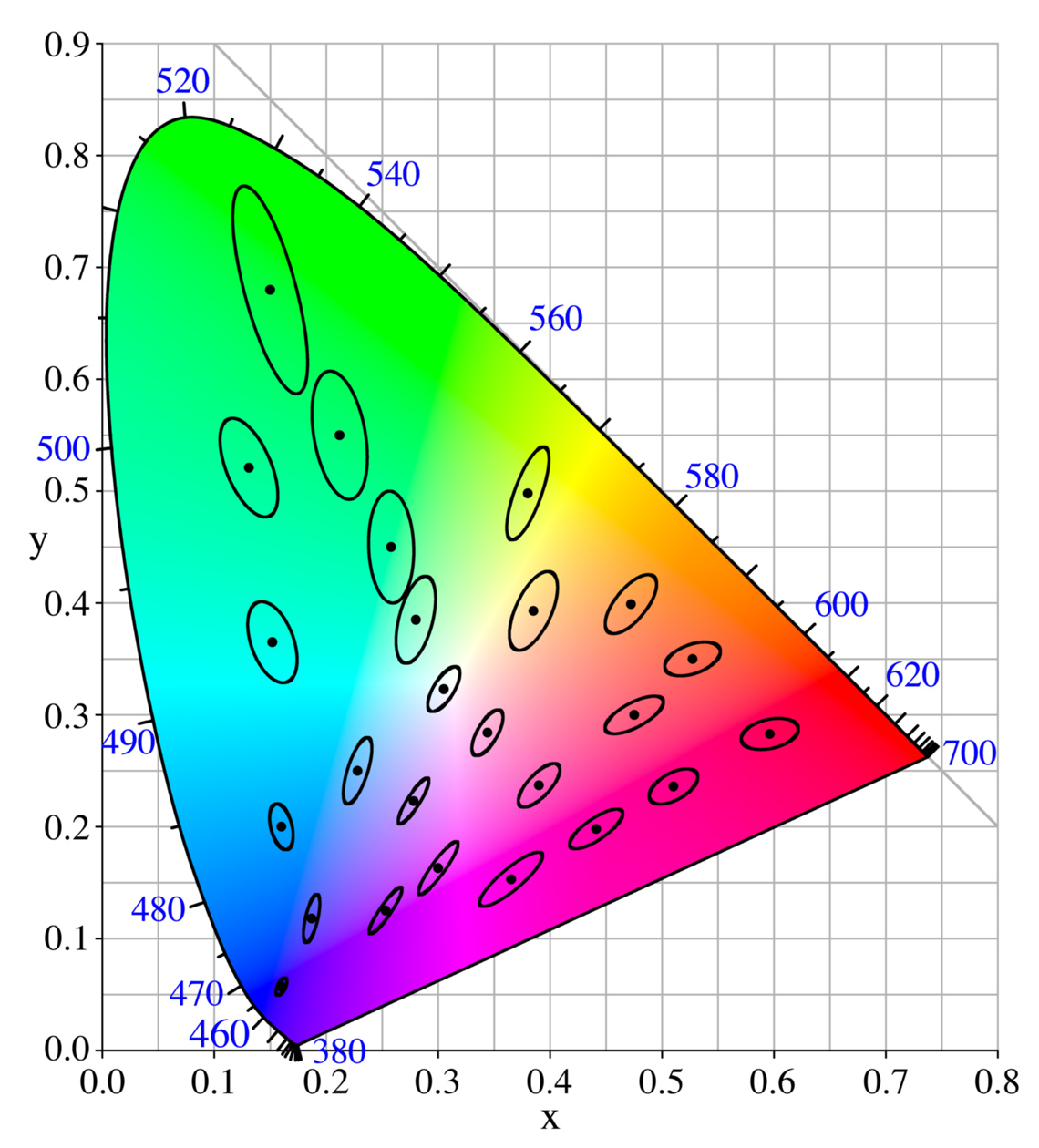
Image courtesy of Lutron Electronics Co., Inc.
The MacAdam ellipse indicates deviations in light color.
Color Rendering Index (CRI)
CRI represents how well the test source renders color compared to a reference source of the same color temperature. The reference used is the black body curve, which means that the baseline source is an incandescent lamp up to 5000K and daylight above that value. As such, most incandescent sources score nearly 100 on a scale up to 100. CRI was created in the mid-1900s by the International Commission on Illumination, abbreviated CIE due to its French name, the “Commission Internationale de l’Eclairage.”
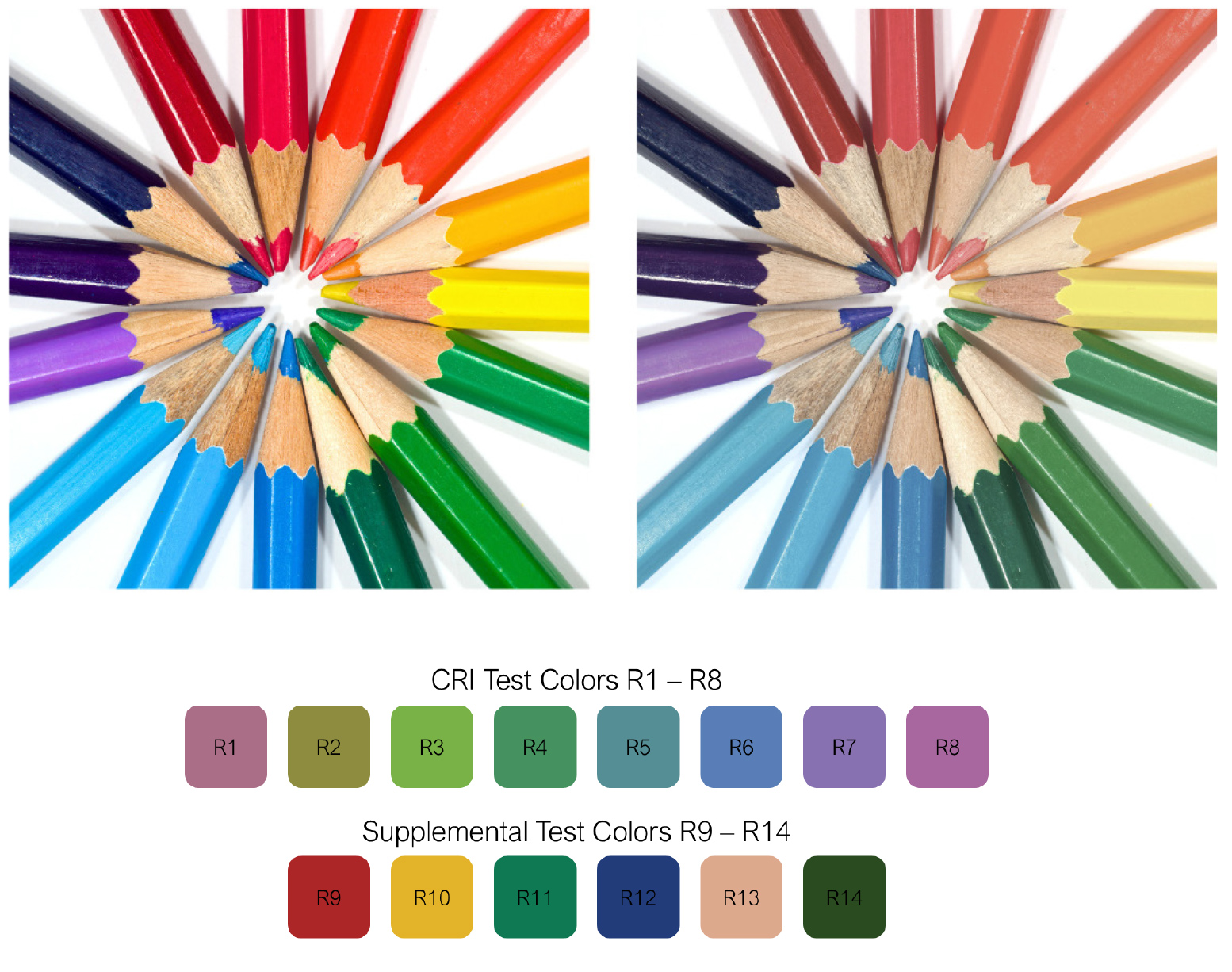
Image courtesy of Lutron Electronics Co., Inc.
The CRI compares a test source to a reference source of the same color temperature.
The CRI value arises from comparing the test source to the reference source for eight pre-defined color samples. The small sample stems from the manual calculation used at the time. One of the issues with CRI is that these eight color samples, R1-R8, do not correctly represent commonly found colors. The eight samples used are pastel colors and do not do a great job representing the color red, which is very widely seen in the world and critical for rendering skin tones. In addition, incandescent sources are very good at rendering the color red, so it is expected that light sources will be able to do this accurately even though it isn’t reflected in their CRI value. The standard defines other color samples, R9-R14, but they are not used in calculating the CRI value. Because of these challenges, CRI does not guarantee overall color rendering quality but how closely they match the colors compared to the reference source.
These specific color samples have enabled some LED companies to focus on the wavelengths that will give them high CRI values and ignore other wavelengths, leading to sources that produce a good CRI but do not render other colors well.
To find these values, no physical test with color samples is ever performed. A Spectral Power Distribution, or SPD, for the source is created using lab equipment. The R-value for each sample is calculated using the values from the test source’s SPD and the known values of the reference source. Each R-value represents the variance between each color sample’s test and reference sources. The values for R1-R8 are then averaged together to determine the “CRI value.”
Color Rendering: TM-30-18
TM-30 is a color metric that the Illuminating Engineering Society (IES) developed. It addresses some of the shortcomings of CRI and looks to expand how color rendering is discussed to relate better to what a source is doing. It uses 99 color samples for its comparison that better represent commonly occurring colors to strengthen the reliability that the metric truly represents the source’s rendering ability within the built environment. This metric also conveys other information, such as saturation (or how vivid a color it can render). Most importantly, red is a primary factor in this calculation.
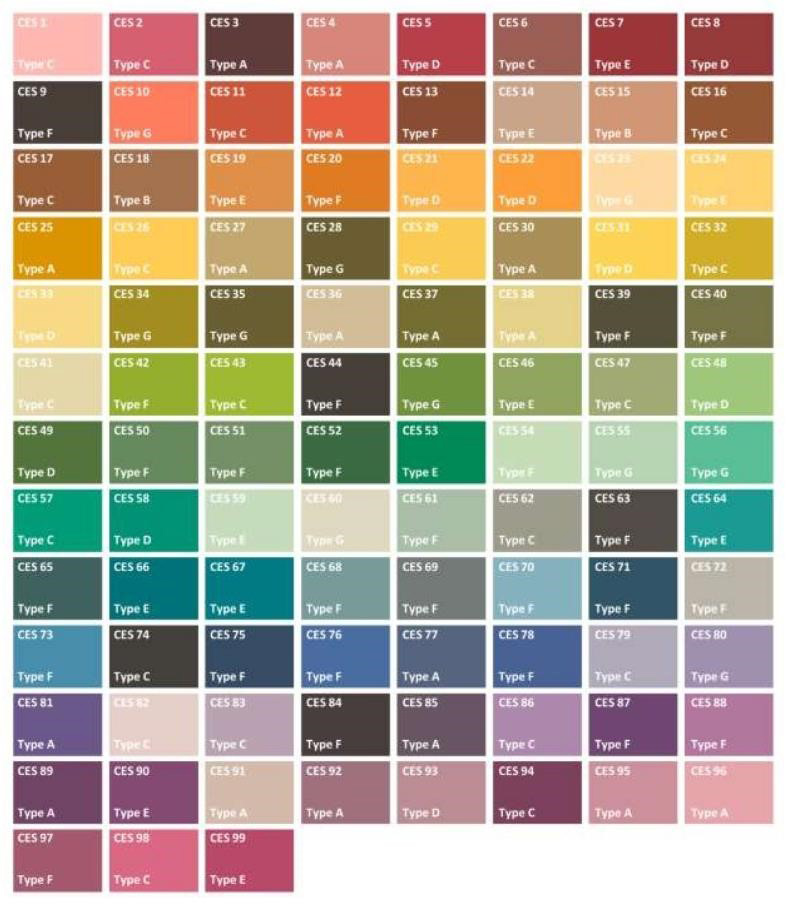
Image courtesy of Lutron Electronics Co., Inc.
TM 30-18 color metric graphic; source IES.
Color Rendering: TM-30-18, Annex E
TM-30 has many components to it in the calculation. A wide variety of metrics represent how a light source performs. Annex E is designed to simplify the metric and provides recommendations for target levels of preference, fidelity, and vividness. Each of those characteristics has three levels. The metrics output from TM-30 determines which level a light source falls into. The visual is attempting to represent that some targets are mutually exclusive. For instance, you cannot have a priority 1 level for vividness while maintaining fidelity.

Image courtesy of Lutron Electronics Co., Inc.; Source: IES
Annex E helps simplify lighting recommendations for target levels of preference, fidelity, and vividness.
Color Shift/Stability
While color consistency refers to sources being close to each other after manufacturing, color shift describes variations that occur to the LEDs over time. The phosphors used in LEDs can deteriorate over time, changing the LEDs’ visible color. This deterioration is usually due to heat, which means that fixture design can help mitigate these effects by helping to minimize that thermal impact. LED fixtures shifting colors over time can make an installation look poor and limit the ability to replace a few fixtures in a space or add fixtures later, as there is the potential that they won’t match the other, older fixtures already installed. Some LEDs have fixed this problem by adding calibration of the source over time.
Low End
The low-end performance of a fixture has always been a vital spec to determine its suitability for different applications. That becomes even more important with LEDs since they often output more lumens than the sources they are replacing, and they are particularly prone to issues at the low end. These issues include pop-on, pop-off, flicker, strobing, and other undesirable effects, often leading to their relatively high low-end capability.
For the sake of this conversation, low end refers to the lowest, stable light output that a source can generate. Low end is measured in a percentage, representing the percent of the high-end light output. Low end is critical because of how eyes perceive light. As the measured amount of light decreases in a space, our pupils dilate and absorb more light, which leads to plateauing of the perceived amount of light in a space.
It is not uncommon for LED sources to have a low end of 20 percent measured light output, which means that a light meter on the table would show an 80 percent decrease in light between high end and low end. Unfortunately, this only comes out to a 45 percent perceived light output, meaning that the lights would appear to still be at half of their original output. This perception makes it critical to find good-performing LEDs that can get to low ends and allow the person in the space to perceive the lights dimming to a reasonable level.
THE IMPORTANCE OF HUMAN-CENTRIC LIGHTING
Human-centric lighting focuses on the well-being of building occupants in addition to meeting energy-saving goals and standards. Natural daylight provides the dynamic light we all desire, with color and intensity that change subtly throughout the day. Human-centric lighting aims to bring that natural light behavior deeper into the interior.
Also valued are views of the outside, which are highly requested as both a beneficial distraction from computer screens and an increased sense of well-being. In a study, participants with large windows and high vegetation content in their view were found to perform 10 to 25 percent better than those with no view. As was reported in the Harvard Business Review, in a study of 1,600 North American employees, 78 percent mention natural light and views directly impacting their overall happiness and well-being.
However, some aspects of daylight merit consideration when designing for increased daylight and views—glare and solar heat gain. Automated shading, which minimizes glare and rejects thermal heat gain, can benefit these spaces.
Designing for Natural Light
Here are the steps for designing for natural light:
- Daylighting design: Use IES recommended practices. Design to (BS)EN 17037:2019 – Daylighting in Buildings.
- Shading selection: Choose an interior shading solution with proper openness factor and total visible light transmittance.
- Lighting selection: Where daylight penetration into the interior ends, choose a tunable white lighting solution that can mimic natural daylight.
Consider Daylight Autonomy (DA) and Spatial Daylight Autonomy (sDA) to determine the ideal amount of natural light. DA is a metric for understanding how much light arrives at points in a space in relation to how much light is available outside. It allows a designer to compare multiple designs with a single value metric for how well the space is daylit.
Specifying the optimal openness factor and visible light transmission for shade fabric is vital for allowing the right amount of direct daylight into the space. Openness factor affects the direct light transmission, while the visible light transmittance affects both the direct light and diffused light. The higher these figures are, the more daylight enters the space. It is important to remember that this can be at odds with the need for glare control. Proper selection is critical and lighting design professionals can aid in this selection. As noted later in the course, an automated shading system that minimizes the need for user operation creates the most consistent benefits.
Where daylight is lacking, creating electric light that mimics natural light is based on a sophisticated solution known as tunable white, which allows the color temperature to be programmed for optimal natural light mimicry.
LIGHT AND WALL CONTROL
Evolution of the Lighting Control Experience
When lighting control emerged in the modern era, a simple switch achieved the desired function. While mundane by today’s standards, it was revolutionary at the time. Before this, people used candles or gas lamps, which both needed to be lit to operate.
Following switching, dimming became widely possible in the early 1960s. Just as daylight gets dimmer at the end of the day, people could dial down the lights accordingly. In many commercial spaces, dimming and switching rose to new levels. As an example, banks of dimmers controlled the lighting in entire restaurants. A permanent marker line often indicated dimmer settings for specific times, which required a worker to adjust the lights, control by control, throughout the day.
Scene control did away with the need for banks of wallbox dimmers. A single button could control many lighting zones to a predetermined level. Personalized control allows spaces to dynamically change as the occupants’ needs change.
Evolution of the Automated Experience
A timeclock is as simple as it sounds. At a specific time of day, the timeclock causes an event, such as shutting off lights. Timeclocks were instigated by energy codes requiring lights to shut off when the building was typically unoccupied. Eventually, this was applied to exterior lighting to ensure they were shut off during the day.
Another iteration of this is the astronomic time clock, which relates the time to an offset from either sunrise or sunset. In this case, for example, the parking lot lighting may shut off 30 minutes after sunrise.
To further save energy, the energy codes started mandating the use of occupancy and vacancy sensors. An occupancy sensor turns lights on when a space becomes occupied and then shuts them off after the room is continuously unoccupied. A vacancy sensor will not turn lights on but will still shut the lights off once everyone has left the space.
The energy benefit is that instead of having the lighting in the whole building be on or off based on when the entire building is typically occupied or unoccupied, now individual spaces can benefit from shutting off lighting based on the occupancy of each space. Take a bathroom, for instance. These spaces are not necessarily continuously occupied, but lights should turn on when someone enters the space and then shut off after someone exits the space. While this may be a convenience aspect for not interacting with the control, this was still a feature added for energy and not for the occupant.
Automated control ensures enough light when daylight is insufficient but dims the light when there is ample daylight. This human-centric strategy means a person does not have to raise or dim the lights just to keep their target illumination levels on their desk or any other work surface.
Automated shade control is all about minimizing glare and reducing solar heat gain. Both of these ensure the comfort of the individual in the space. Fewer than 10 percent of manual shades are moved more than once per day, so even if a person minimized glare by closing the shades, they are unlikely to benefit from having the shades open for views when the sun is no longer entering the room.
Daylight mimicry is an automation for the electric lighting in the room. Generally, this is a tunable white light source that can change its color temperature based on the time of day to mimic the natural rhythms of the day. This automation was designed for the occupants’ well-being and not for energy savings. Even in an interior room without access to daylight, an occupant can experience the daily change in color temperatures that mimic daylight.
TECHNOLOGY CONSIDERATIONS
Following are the technology considerations for human-centric lighting.
What is Dynamic Light?
Beyond what switching and dimming have provided regarding adjustability in light level, there is also the concept of dynamic light. Today, we can find lamps that provide warm dimming, mimicking the warming effect of incandescent lamps as they dim. Tunable white is a lighting technology that allows for variation in color temperature at any dimming level. Color changing has been around for a long time but has become even easier with LEDs to access a wide array of saturated colors.
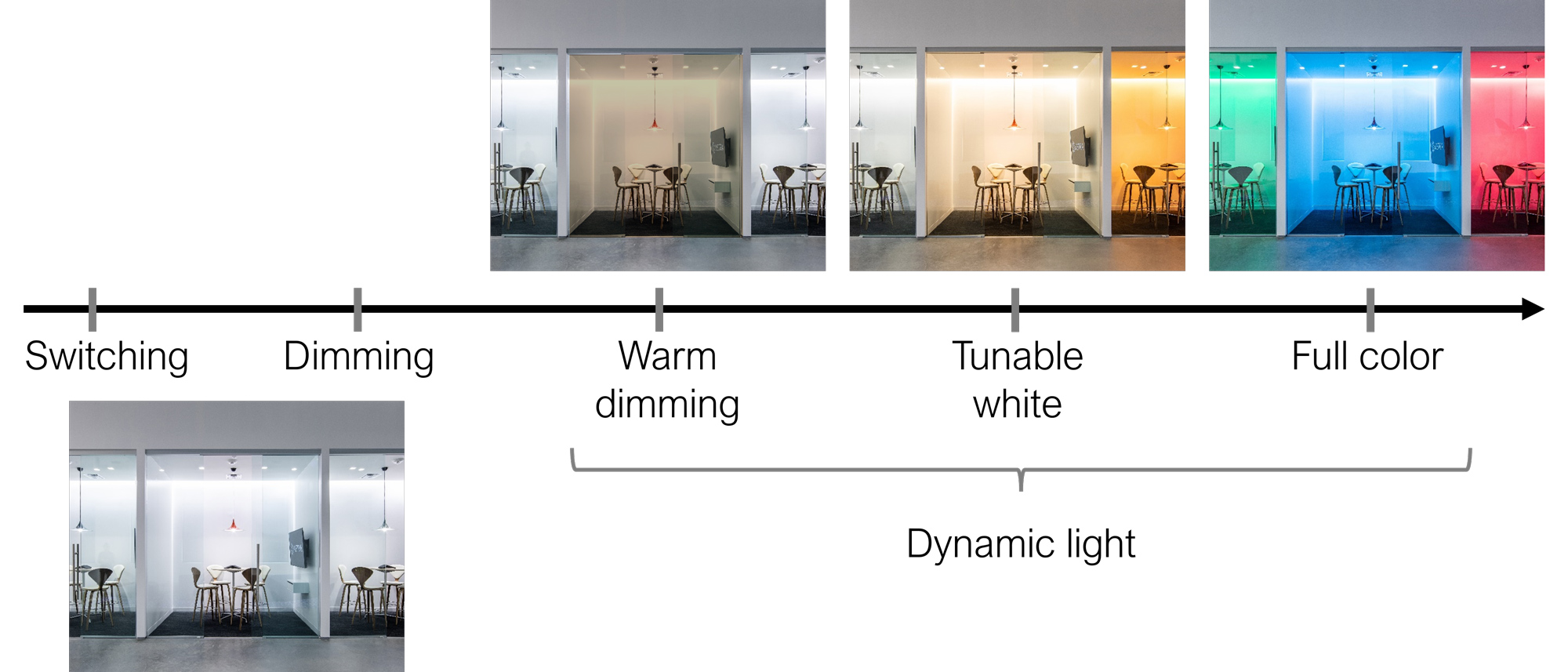
Image courtesy of Lutron Electronics Co., Inc.
Dynamic light mimics natural light.
Static White
Static white LEDs maintain a consistent color temperature, providing a stable lighting environment without adjustable features. Although dimmable, static white LEDs compromise on color temperature, limiting their adaptability in dynamic lighting scenarios. Static white LEDs find application in environments with minimal color demand. The primary reasons they are used are cost, control complexity, and availability.

Image courtesy of Lutron Electronics Co., Inc.
Static white LEDs do not have adjustable features.
Warm Dim
Warm dimming means the light source’s color temperature warms as the light dims. It has a similar feel to incandescent light in that its coolest light output comes at high end, and its warmest light output comes at low end. This similarity to incandescent sources is the benefit of pushing the technology, giving people a familiar experience.
One of the concerns of warm dimming is that it is relatively inflexible. Like incandescent, you are locked into a specific CCT for each intensity. You cannot decide if you want a dim, cool, or full warm light.
The other downside is that more philosophical arguments are occurring in the lighting industry. While this technology makes LEDs seem more like incandescent, is that the direction we want to go? LEDs are a powerful tool that can do many different things, so should we lock into this limiting technology to mimic the older technology?
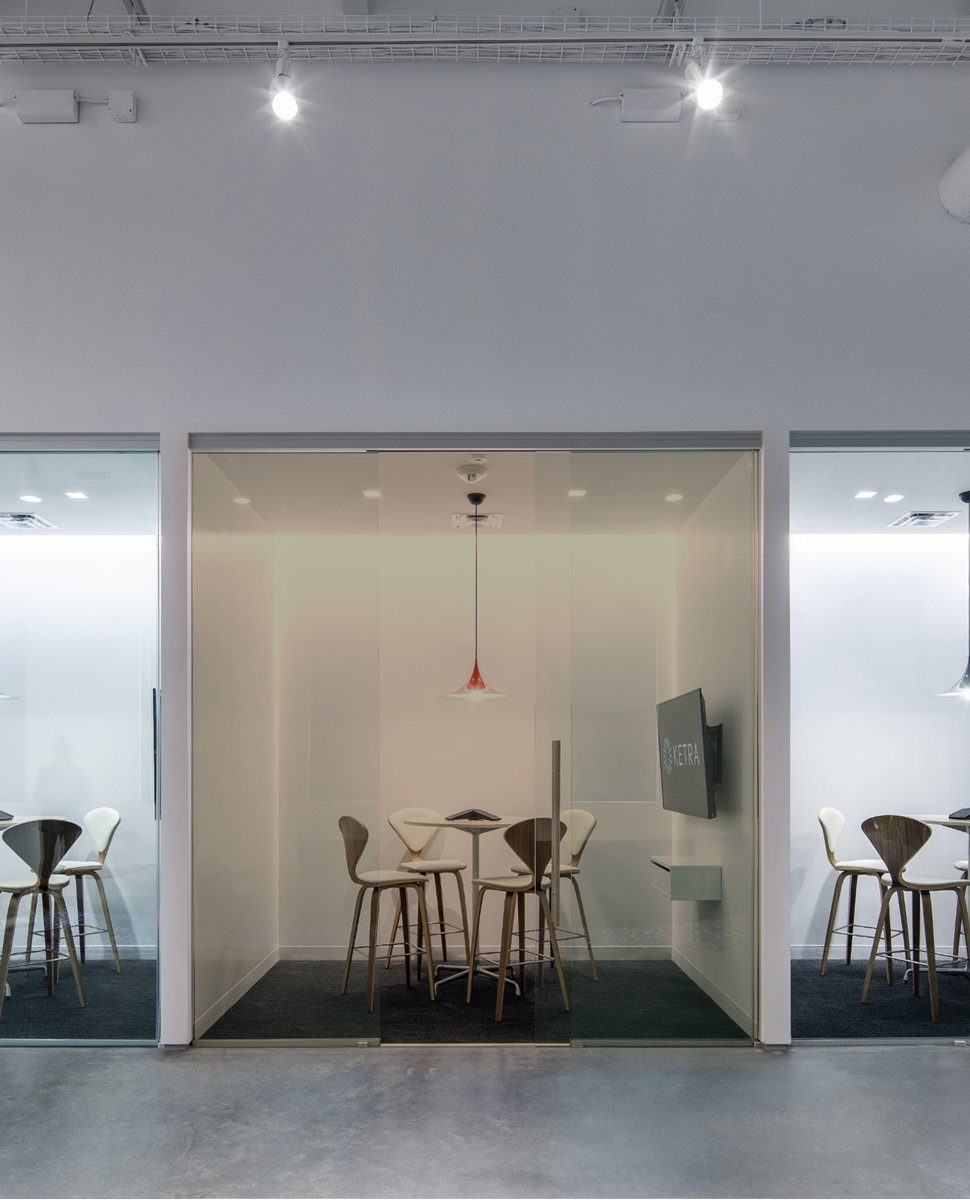
Image courtesy of Lutron Electronics Co., Inc.
Warm dimming has a similar feel to incandescent lighting.
Tunable White
Tunable white technology allows for independent control of intensity and color temperature. In the past, some light sources forced the user to control one warm and one cool intensity and mix them to get the desired brightness and color temperature, which is a complicated process. While some of that persists today, DALI 2 DT8 and other protocols require a single digital address to control both intensity and CCT. As a result of decoupling the two values, the user decides the color temperature and intensity.
When paired with a lighting control system, as it almost always will be, tools like astronomic timeclocks can change the color temperature throughout the day, allowing for warm lighting in the mornings and evenings and cool light in the afternoons. This pattern mimics the cycle of the sun, to which human bodies respond.

Image courtesy of Lutron Electronics Co., Inc.
With tunable white, the user decides the color temperature and intensity.
Full-Color Control
Color mixing allows for complete color control to create any color, not just different hues of white, usually accomplished by mixing red, green, and blue light (commonly referred to as RGB). This technology gives users a color-changing fixture to adjust for their specific application. RGB was initially used primarily for theatrical lighting, giving flexibility for usage as stage lighting. In more recent years, as LED technology improved and more control systems started supporting it, color mixing has made its way into more mainstream lighting. They can now be found in many commercial and residential applications as accent pieces, decorative pieces, or other specific applications.
Some of the concerns with color mixing are the requirements for a mixing algorithm to create different colors. This is almost always achieved by adding some kind of show controller that houses the mixing logic and provides the user with the interface to make their adjustments. These controllers, depending on their capability, can be expensive. Another common concern is the source’s color rendering ability. While most color-changing fixtures use three colors—red, green, and blue—more colors are needed for better color rendering, increasing the light source’s capability and price and making the mixing algorithm and controllers more complicated.
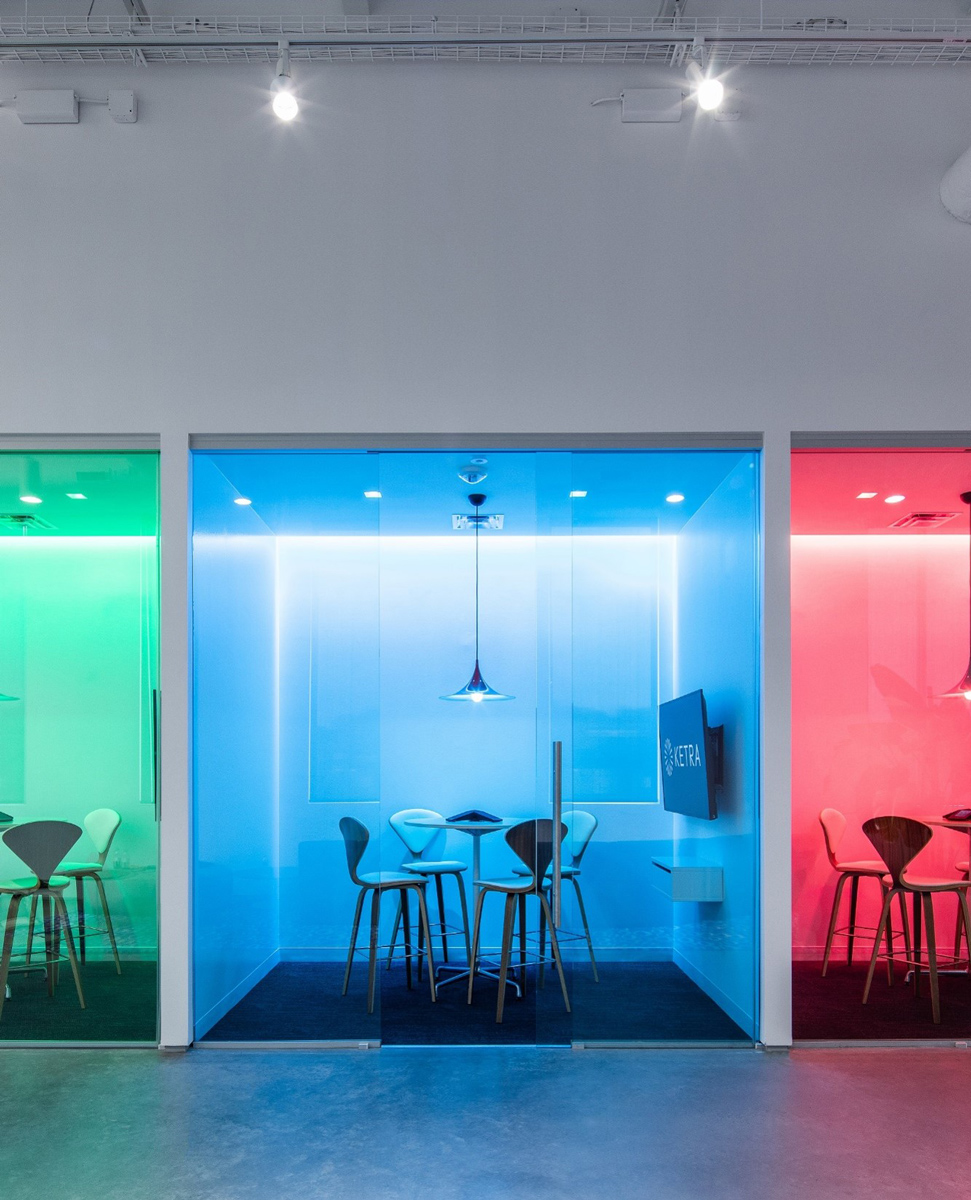
Image courtesy of Lutron Electronics Co., Inc.
Color mixing allows for complete color control.
Natural Light Control Technologies
Although the least expensive option is manual control (which does not require motors), this control method limits the amount of daylight and views as users infrequently operate manual shades. Research indicates, on average, that less than 10 percent of manual shades are moved more than once per day.1 As a result, the potential benefits of daylighting, views, and energy savings are unrealized.
Motorized shades make it easier to move the shades and can improve building aesthetics by maintaining alignment. However, if they remain undeployed, motorized shades provide little value in optimizing for views, daylight autonomy, and energy efficiency.
To get the full value out of a fenestration system, automated shades maximize comfort and energy efficiency by keeping the shades as open as they can be without causing glare. In addition, the incremental cost of going from a motorized to an automated system is relatively small. The most significant cost is motorizing the system. Based on this, an automated system is the best choice for improving building performance and aesthetics.
Automation Leads to Improved Energy Performance
Manual shades in commercial spaces are generally not moved, primarily due to a lack of ownership of controlling these shades. People will usually move shades when they are uncomfortable, such as when there is glare. However, they don’t think to move them when the glare is gone, leaving the shades too closed to maximize the amount of glare-free daylight and views.

Image courtesy of Lutron Electronics Co., Inc.
In a simulation, the automated shade system allows in more natural light (yellow) while minimizing glare during certain times of the day.
The images on this chart highlight the limited daylight received when using manual shades. The yellow indicates a valuable amount of daylight (between 20 and 200FC) for more than 50 percent of work hours. The purple zone shows where there is too little daylight, requiring significant electric light supplement.
As illustrated on the left, where the shades were mostly closed all year, much less beneficial daylight is coming into the building. The automated shades on the right show a significant increase in beneficial daylight, which will also result in energy savings via daylight harvesting.
The current version of IECC requires two daylight zones, and the next version of IECC requires daylighting in smaller areas. Automated shading solutions can help maximize the investment in what is required in the building per code. Providing equipment for daylighting is required, so automating the shades allows full utilization of available natural light and saving more energy.
SEQUENCE OF OPERATIONS FOR HUMAN-CENTRIC LIGHTING DESIGN
These are the requirements to implement a human-centric lighting design:
- Verify the sequence of operations for optimal lighting scenarios.
- Work with the fixture manufacturer.
- Match controls and fixtures for the desired outcome.
- Work with the client to explain the differences between warm/cool and intensity/CCT.
- Work with the client to explain the importance of tunable white and human-centric lighting.
The first part of implementing human-centric lighting is understanding how people want to use the space. The designer should discuss various scenarios for the activities that people often do in the space and determine how the lights need to respond.
For example, in a conference room, an occupant may present over a video call, use the markerboard, or show a video clip. Each of these may require different distributions and intensity for the lights.
Once the goals for the lights are established, the designer should work with the fixture manufacturer to ensure the desired fixtures can perform in the way necessary to match the sequence of operations. Ensure that the controls and the fixtures can work together from a protocol perspective. Answer questions that come up as to why a particular functionality is needed (such as intensity and CCT control tunable-white fixtures as opposed to warm-cool-controlled tunable white). Ensure that the human-centric lighting benefits you would like to achieve are essential to the client and explain how the sequence of operations, fixture selection, and control system supports that goal.
Five Questions to Consider for a Tunable White Job
- What are the control inputs to the fixture (warm intensity/cool intensity or CCT/intensity)?
- Are the control inputs digital (Digital=DALI, DMX. Analog=0-10V)?
- What are the maximum and minimum CCTs for all fixtures?
- Is the fixture a two-color white or a multi-color LED fixture?
- What is the sequence of operations?
Considerations
The feeling the designer wants to create varies between space types, with different sequences required to feel natural. A residential-feeling office differs from that of a traditional office space. The lighting controls company needs to know how the clients want the system to behave. For its new headquarters, as seen in the case study, BlackRock assembled a skilled team that understood the vital role of lighting and shading in creating a unified, comfortable, and adaptable atmosphere. Features included tunable white lighting, daylighting, automated shading, and a sequence of operations designed to mimic the sun’s natural progression.
CONCLUSION/SUMMARY
Lighting control for electric and natural light continues to evolve and improve the occupant experience. It also helps to meet building and energy-saving goals. There are many ways to implement human-centric lighting on projects. Understanding the nature and science of lighting leads to better specifications to meet human needs. Automated shading helps ensure the best daylighting environment for occupant wellness and business success.
END NOTES
1Source: Estia SA. 2014. OFEN Project: EPFL Innovation Park.
Kathy Price-Robinson writes about building and design. Her remodeling series “Pardon Our Dust” ran for 12 years in the Los Angeles Times. She specializes in writing about buildings that are durable and resilient to climate disruptions, as well as products and designs that provide shade in hot climates. www.kathyprice.com

Photo: Connie Zhou
Automated lighting and shading create a human-centric lighting experience for the occupants’ well-being.
EVOLUTION OF THE LIGHTING EXPERIENCE
Before the invention of electric lights, gas lamps, and candles, humans lived and worked under the natural rhythms of daylight. Daylight is a dynamic light source that changes daily (dark/light), seasonally (sunrise/sunset times), and within the day due to weather changes. This dynamic nature of daylight creates visual interest through color temperature, distribution, and brightness changes.
Firelight is the next natural light source in the evolution of lighting. This light source was not controlled until humans learned how to create and harness fire. It is a dynamic light source that moves, emits various warm tones, and provides a relaxing environment.
In the evolution of lighting, we will skip past many human-made light sources (candles, gas lights, carbon arc lamps, etc.) and go directly to one of the most beloved light sources, the incandescent lamp. This was the first standardized electric light source that allowed easy lighting control in homes or buildings with a simple switch.
Originally, lights could only be switched on or off, but eventually, dimming became an option. With dimming, people could warm dim the light, a natural feature of how the light is created (heating the tungsten filament). The incandescent lamp is capable of ultra-low light levels. Eventually, lighting needed to be more efficient because most of the energy from an incandescent lamp was output as heat rather than light.
The fluorescent lamp came in various form factors throughout its history. While this light source significantly improved energy efficiency, the light had many drawbacks. First, people often disliked the color quality of the light. The lamp startup was frequently slow, meaning it took a while for the light to get to full brightness (especially true in compact fluorescents). Finally, while the light sources could eventually be dimmed, fluorescent lamps did not warm dim, a key feature of the incandescent light. Nevertheless, the market shifted to fluorescent lighting due to energy savings, which was heavily marketed for its benefits, but many customers remained dissatisfied with the results.
The initial LEDs offered more significant energy savings than fluorescent lighting. These lamps did not suffer from slow startup, reaching full brightness immediately.
The challenges were color quality and dimming. The inability to warm dim persisted in the evolution from fluorescent to LEDs. Homeowners would unscrew an incandescent or compact fluorescent lamp (CFL) and install an LED lamp on a dimmer, but the lamp would not operate as preferred─leading to flicker, drop out, and other challenges. As a result, standards have developed to aid in compatibility.
Today, the LED is the most prominent light source. It is more energy efficient than its predecessors, has better color quality, and more desirable features. LEDs can warm and dim, just like incandescent lights. Dimming is much easier today than it was a decade ago. Some of these light sources even add features such as tunable white or full color control (to be discussed later).
Daylight Intensity and Variability
Let’s look at typical light levels of interior and exterior environments to illustrate the variability in daylight conditions. Most recommended interior light levels are between 10 and 50 footcandles, while exterior daylight conditions vary between 500 and 10,000 footcandles.
This range of daylight conditions makes it particularly difficult to use passive (fixed) shading (i.e., overhangs, permanent glass tint, fixed louvers, light shelves, etc.) and have high performance throughout the day. An active, dynamic system is the only way to maximize daylight throughout the day/week/month/year. Designers can optimize natural light for a point on the scale of conditions but not for the entire scale.
Correlated Color Temperature (CCT)
Correlated Color Temperature (CCT) measures how warm or cool a light source appears. The higher the number, the cooler the light appears. Lower numbers indicate a warmer appearance.
The unit of measure for CCT is Kelvin (Kelvin is an absolute measurement, and not “degrees Kelvin”), as it is actually a description of the temperature that a black body emitter would have to be heated to glow a specific color (an example is iron heated by a blacksmith, or the tungsten filament of an incandescent bulb). Because of this relationship, the black body curve refers to the range of reds, oranges, and whites made when heating the black body emitter (e.g. the tungsten filament incandescent) to different temperatures (e.g. dimmed level).
While it is somewhat counter-intuitive that the higher Kelvin number is a cooler temperature, think of an incandescent lamp. As more power flows through it, it is at a higher temperature, and its color is cooler. As it dims down, lowering its temperature, the light gets warmer in appearance. For reference of this scale, an incandescent lamp will usually range from about 1600K to 3000K from low end to high end.
THE PHYSICS OF TUNABLE WHITE
Color Space
This image is what’s known as a color space. It is a representation of all possible visible colors of light. This particular space is the x,y space. Other color spaces serve different purposes. Each point within the color space has a set of coordinates describing its location within the space, known as its chromaticity coordinates. These coordinates identify the exact color of light and result from a spectrophotometer, among other tools.

Image courtesy of Lutron Electronics Co., Inc.
Color space represents all possible colors of light.
The boundary of color space is defined by monochromatic light, a single wavelength of light, and everything inside from the edge is a mix of wavelengths. The axis, x, and y, are unitless and represent relative amounts of light: x being the relative amount of red light, and y being the relative amount of green light.
As discussed earlier, the curve highlighted in the middle is the black body curve or black body locus. It represents all of the possible white lights along the range of color temperatures. Along this curve are the commonly used CCTs.
MacAdam Ellipse
Many light source spec sheets refer to color difference or SDCM (Standard Deviations of Color Matching) or MacAdam ellipses. The SDCM indicates the likelihood that someone would notice a difference between a light source with a given set of x,y values and a comparison light source with another set of x,y values.
This color-matching deviation is an important concept when specifying a project’s lighting. Sometimes, a manufacturer may say their LEDs are within a two-step MacAdam ellipse. This means that 95% (two standard deviations) would notice a difference between the center of the ellipse and the boundary of the ellipse between those two points. In this drawing, the ellipses are scaled up to be able to see them. They are 10 times the size they would normally be for a 1-step MacAdam ellipse.

Image courtesy of Lutron Electronics Co., Inc.
The MacAdam ellipse indicates deviations in light color.
Color Rendering Index (CRI)
CRI represents how well the test source renders color compared to a reference source of the same color temperature. The reference used is the black body curve, which means that the baseline source is an incandescent lamp up to 5000K and daylight above that value. As such, most incandescent sources score nearly 100 on a scale up to 100. CRI was created in the mid-1900s by the International Commission on Illumination, abbreviated CIE due to its French name, the “Commission Internationale de l’Eclairage.”

Image courtesy of Lutron Electronics Co., Inc.
The CRI compares a test source to a reference source of the same color temperature.
The CRI value arises from comparing the test source to the reference source for eight pre-defined color samples. The small sample stems from the manual calculation used at the time. One of the issues with CRI is that these eight color samples, R1-R8, do not correctly represent commonly found colors. The eight samples used are pastel colors and do not do a great job representing the color red, which is very widely seen in the world and critical for rendering skin tones. In addition, incandescent sources are very good at rendering the color red, so it is expected that light sources will be able to do this accurately even though it isn’t reflected in their CRI value. The standard defines other color samples, R9-R14, but they are not used in calculating the CRI value. Because of these challenges, CRI does not guarantee overall color rendering quality but how closely they match the colors compared to the reference source.
These specific color samples have enabled some LED companies to focus on the wavelengths that will give them high CRI values and ignore other wavelengths, leading to sources that produce a good CRI but do not render other colors well.
To find these values, no physical test with color samples is ever performed. A Spectral Power Distribution, or SPD, for the source is created using lab equipment. The R-value for each sample is calculated using the values from the test source’s SPD and the known values of the reference source. Each R-value represents the variance between each color sample’s test and reference sources. The values for R1-R8 are then averaged together to determine the “CRI value.”
Color Rendering: TM-30-18
TM-30 is a color metric that the Illuminating Engineering Society (IES) developed. It addresses some of the shortcomings of CRI and looks to expand how color rendering is discussed to relate better to what a source is doing. It uses 99 color samples for its comparison that better represent commonly occurring colors to strengthen the reliability that the metric truly represents the source’s rendering ability within the built environment. This metric also conveys other information, such as saturation (or how vivid a color it can render). Most importantly, red is a primary factor in this calculation.

Image courtesy of Lutron Electronics Co., Inc.
TM 30-18 color metric graphic; source IES.
Color Rendering: TM-30-18, Annex E
TM-30 has many components to it in the calculation. A wide variety of metrics represent how a light source performs. Annex E is designed to simplify the metric and provides recommendations for target levels of preference, fidelity, and vividness. Each of those characteristics has three levels. The metrics output from TM-30 determines which level a light source falls into. The visual is attempting to represent that some targets are mutually exclusive. For instance, you cannot have a priority 1 level for vividness while maintaining fidelity.

Image courtesy of Lutron Electronics Co., Inc.; Source: IES
Annex E helps simplify lighting recommendations for target levels of preference, fidelity, and vividness.
Color Shift/Stability
While color consistency refers to sources being close to each other after manufacturing, color shift describes variations that occur to the LEDs over time. The phosphors used in LEDs can deteriorate over time, changing the LEDs’ visible color. This deterioration is usually due to heat, which means that fixture design can help mitigate these effects by helping to minimize that thermal impact. LED fixtures shifting colors over time can make an installation look poor and limit the ability to replace a few fixtures in a space or add fixtures later, as there is the potential that they won’t match the other, older fixtures already installed. Some LEDs have fixed this problem by adding calibration of the source over time.
Low End
The low-end performance of a fixture has always been a vital spec to determine its suitability for different applications. That becomes even more important with LEDs since they often output more lumens than the sources they are replacing, and they are particularly prone to issues at the low end. These issues include pop-on, pop-off, flicker, strobing, and other undesirable effects, often leading to their relatively high low-end capability.
For the sake of this conversation, low end refers to the lowest, stable light output that a source can generate. Low end is measured in a percentage, representing the percent of the high-end light output. Low end is critical because of how eyes perceive light. As the measured amount of light decreases in a space, our pupils dilate and absorb more light, which leads to plateauing of the perceived amount of light in a space.
It is not uncommon for LED sources to have a low end of 20 percent measured light output, which means that a light meter on the table would show an 80 percent decrease in light between high end and low end. Unfortunately, this only comes out to a 45 percent perceived light output, meaning that the lights would appear to still be at half of their original output. This perception makes it critical to find good-performing LEDs that can get to low ends and allow the person in the space to perceive the lights dimming to a reasonable level.
THE IMPORTANCE OF HUMAN-CENTRIC LIGHTING
Human-centric lighting focuses on the well-being of building occupants in addition to meeting energy-saving goals and standards. Natural daylight provides the dynamic light we all desire, with color and intensity that change subtly throughout the day. Human-centric lighting aims to bring that natural light behavior deeper into the interior.
Also valued are views of the outside, which are highly requested as both a beneficial distraction from computer screens and an increased sense of well-being. In a study, participants with large windows and high vegetation content in their view were found to perform 10 to 25 percent better than those with no view. As was reported in the Harvard Business Review, in a study of 1,600 North American employees, 78 percent mention natural light and views directly impacting their overall happiness and well-being.
However, some aspects of daylight merit consideration when designing for increased daylight and views—glare and solar heat gain. Automated shading, which minimizes glare and rejects thermal heat gain, can benefit these spaces.
Designing for Natural Light
Here are the steps for designing for natural light:
- Daylighting design: Use IES recommended practices. Design to (BS)EN 17037:2019 – Daylighting in Buildings.
- Shading selection: Choose an interior shading solution with proper openness factor and total visible light transmittance.
- Lighting selection: Where daylight penetration into the interior ends, choose a tunable white lighting solution that can mimic natural daylight.
Consider Daylight Autonomy (DA) and Spatial Daylight Autonomy (sDA) to determine the ideal amount of natural light. DA is a metric for understanding how much light arrives at points in a space in relation to how much light is available outside. It allows a designer to compare multiple designs with a single value metric for how well the space is daylit.
Specifying the optimal openness factor and visible light transmission for shade fabric is vital for allowing the right amount of direct daylight into the space. Openness factor affects the direct light transmission, while the visible light transmittance affects both the direct light and diffused light. The higher these figures are, the more daylight enters the space. It is important to remember that this can be at odds with the need for glare control. Proper selection is critical and lighting design professionals can aid in this selection. As noted later in the course, an automated shading system that minimizes the need for user operation creates the most consistent benefits.
Where daylight is lacking, creating electric light that mimics natural light is based on a sophisticated solution known as tunable white, which allows the color temperature to be programmed for optimal natural light mimicry.
LIGHT AND WALL CONTROL
Evolution of the Lighting Control Experience
When lighting control emerged in the modern era, a simple switch achieved the desired function. While mundane by today’s standards, it was revolutionary at the time. Before this, people used candles or gas lamps, which both needed to be lit to operate.
Following switching, dimming became widely possible in the early 1960s. Just as daylight gets dimmer at the end of the day, people could dial down the lights accordingly. In many commercial spaces, dimming and switching rose to new levels. As an example, banks of dimmers controlled the lighting in entire restaurants. A permanent marker line often indicated dimmer settings for specific times, which required a worker to adjust the lights, control by control, throughout the day.
Scene control did away with the need for banks of wallbox dimmers. A single button could control many lighting zones to a predetermined level. Personalized control allows spaces to dynamically change as the occupants’ needs change.
Evolution of the Automated Experience
A timeclock is as simple as it sounds. At a specific time of day, the timeclock causes an event, such as shutting off lights. Timeclocks were instigated by energy codes requiring lights to shut off when the building was typically unoccupied. Eventually, this was applied to exterior lighting to ensure they were shut off during the day.
Another iteration of this is the astronomic time clock, which relates the time to an offset from either sunrise or sunset. In this case, for example, the parking lot lighting may shut off 30 minutes after sunrise.
To further save energy, the energy codes started mandating the use of occupancy and vacancy sensors. An occupancy sensor turns lights on when a space becomes occupied and then shuts them off after the room is continuously unoccupied. A vacancy sensor will not turn lights on but will still shut the lights off once everyone has left the space.
The energy benefit is that instead of having the lighting in the whole building be on or off based on when the entire building is typically occupied or unoccupied, now individual spaces can benefit from shutting off lighting based on the occupancy of each space. Take a bathroom, for instance. These spaces are not necessarily continuously occupied, but lights should turn on when someone enters the space and then shut off after someone exits the space. While this may be a convenience aspect for not interacting with the control, this was still a feature added for energy and not for the occupant.
Automated control ensures enough light when daylight is insufficient but dims the light when there is ample daylight. This human-centric strategy means a person does not have to raise or dim the lights just to keep their target illumination levels on their desk or any other work surface.
Automated shade control is all about minimizing glare and reducing solar heat gain. Both of these ensure the comfort of the individual in the space. Fewer than 10 percent of manual shades are moved more than once per day, so even if a person minimized glare by closing the shades, they are unlikely to benefit from having the shades open for views when the sun is no longer entering the room.
Daylight mimicry is an automation for the electric lighting in the room. Generally, this is a tunable white light source that can change its color temperature based on the time of day to mimic the natural rhythms of the day. This automation was designed for the occupants’ well-being and not for energy savings. Even in an interior room without access to daylight, an occupant can experience the daily change in color temperatures that mimic daylight.
TECHNOLOGY CONSIDERATIONS
Following are the technology considerations for human-centric lighting.
What is Dynamic Light?
Beyond what switching and dimming have provided regarding adjustability in light level, there is also the concept of dynamic light. Today, we can find lamps that provide warm dimming, mimicking the warming effect of incandescent lamps as they dim. Tunable white is a lighting technology that allows for variation in color temperature at any dimming level. Color changing has been around for a long time but has become even easier with LEDs to access a wide array of saturated colors.

Image courtesy of Lutron Electronics Co., Inc.
Dynamic light mimics natural light.
Static White
Static white LEDs maintain a consistent color temperature, providing a stable lighting environment without adjustable features. Although dimmable, static white LEDs compromise on color temperature, limiting their adaptability in dynamic lighting scenarios. Static white LEDs find application in environments with minimal color demand. The primary reasons they are used are cost, control complexity, and availability.

Image courtesy of Lutron Electronics Co., Inc.
Static white LEDs do not have adjustable features.
Warm Dim
Warm dimming means the light source’s color temperature warms as the light dims. It has a similar feel to incandescent light in that its coolest light output comes at high end, and its warmest light output comes at low end. This similarity to incandescent sources is the benefit of pushing the technology, giving people a familiar experience.
One of the concerns of warm dimming is that it is relatively inflexible. Like incandescent, you are locked into a specific CCT for each intensity. You cannot decide if you want a dim, cool, or full warm light.
The other downside is that more philosophical arguments are occurring in the lighting industry. While this technology makes LEDs seem more like incandescent, is that the direction we want to go? LEDs are a powerful tool that can do many different things, so should we lock into this limiting technology to mimic the older technology?

Image courtesy of Lutron Electronics Co., Inc.
Warm dimming has a similar feel to incandescent lighting.
Tunable White
Tunable white technology allows for independent control of intensity and color temperature. In the past, some light sources forced the user to control one warm and one cool intensity and mix them to get the desired brightness and color temperature, which is a complicated process. While some of that persists today, DALI 2 DT8 and other protocols require a single digital address to control both intensity and CCT. As a result of decoupling the two values, the user decides the color temperature and intensity.
When paired with a lighting control system, as it almost always will be, tools like astronomic timeclocks can change the color temperature throughout the day, allowing for warm lighting in the mornings and evenings and cool light in the afternoons. This pattern mimics the cycle of the sun, to which human bodies respond.

Image courtesy of Lutron Electronics Co., Inc.
With tunable white, the user decides the color temperature and intensity.
Full-Color Control
Color mixing allows for complete color control to create any color, not just different hues of white, usually accomplished by mixing red, green, and blue light (commonly referred to as RGB). This technology gives users a color-changing fixture to adjust for their specific application. RGB was initially used primarily for theatrical lighting, giving flexibility for usage as stage lighting. In more recent years, as LED technology improved and more control systems started supporting it, color mixing has made its way into more mainstream lighting. They can now be found in many commercial and residential applications as accent pieces, decorative pieces, or other specific applications.
Some of the concerns with color mixing are the requirements for a mixing algorithm to create different colors. This is almost always achieved by adding some kind of show controller that houses the mixing logic and provides the user with the interface to make their adjustments. These controllers, depending on their capability, can be expensive. Another common concern is the source’s color rendering ability. While most color-changing fixtures use three colors—red, green, and blue—more colors are needed for better color rendering, increasing the light source’s capability and price and making the mixing algorithm and controllers more complicated.

Image courtesy of Lutron Electronics Co., Inc.
Color mixing allows for complete color control.
Natural Light Control Technologies
Although the least expensive option is manual control (which does not require motors), this control method limits the amount of daylight and views as users infrequently operate manual shades. Research indicates, on average, that less than 10 percent of manual shades are moved more than once per day.1 As a result, the potential benefits of daylighting, views, and energy savings are unrealized.
Motorized shades make it easier to move the shades and can improve building aesthetics by maintaining alignment. However, if they remain undeployed, motorized shades provide little value in optimizing for views, daylight autonomy, and energy efficiency.
To get the full value out of a fenestration system, automated shades maximize comfort and energy efficiency by keeping the shades as open as they can be without causing glare. In addition, the incremental cost of going from a motorized to an automated system is relatively small. The most significant cost is motorizing the system. Based on this, an automated system is the best choice for improving building performance and aesthetics.
Automation Leads to Improved Energy Performance
Manual shades in commercial spaces are generally not moved, primarily due to a lack of ownership of controlling these shades. People will usually move shades when they are uncomfortable, such as when there is glare. However, they don’t think to move them when the glare is gone, leaving the shades too closed to maximize the amount of glare-free daylight and views.

Image courtesy of Lutron Electronics Co., Inc.
In a simulation, the automated shade system allows in more natural light (yellow) while minimizing glare during certain times of the day.
The images on this chart highlight the limited daylight received when using manual shades. The yellow indicates a valuable amount of daylight (between 20 and 200FC) for more than 50 percent of work hours. The purple zone shows where there is too little daylight, requiring significant electric light supplement.
As illustrated on the left, where the shades were mostly closed all year, much less beneficial daylight is coming into the building. The automated shades on the right show a significant increase in beneficial daylight, which will also result in energy savings via daylight harvesting.
The current version of IECC requires two daylight zones, and the next version of IECC requires daylighting in smaller areas. Automated shading solutions can help maximize the investment in what is required in the building per code. Providing equipment for daylighting is required, so automating the shades allows full utilization of available natural light and saving more energy.
SEQUENCE OF OPERATIONS FOR HUMAN-CENTRIC LIGHTING DESIGN
These are the requirements to implement a human-centric lighting design:
- Verify the sequence of operations for optimal lighting scenarios.
- Work with the fixture manufacturer.
- Match controls and fixtures for the desired outcome.
- Work with the client to explain the differences between warm/cool and intensity/CCT.
- Work with the client to explain the importance of tunable white and human-centric lighting.
The first part of implementing human-centric lighting is understanding how people want to use the space. The designer should discuss various scenarios for the activities that people often do in the space and determine how the lights need to respond.
For example, in a conference room, an occupant may present over a video call, use the markerboard, or show a video clip. Each of these may require different distributions and intensity for the lights.
Once the goals for the lights are established, the designer should work with the fixture manufacturer to ensure the desired fixtures can perform in the way necessary to match the sequence of operations. Ensure that the controls and the fixtures can work together from a protocol perspective. Answer questions that come up as to why a particular functionality is needed (such as intensity and CCT control tunable-white fixtures as opposed to warm-cool-controlled tunable white). Ensure that the human-centric lighting benefits you would like to achieve are essential to the client and explain how the sequence of operations, fixture selection, and control system supports that goal.
Five Questions to Consider for a Tunable White Job
- What are the control inputs to the fixture (warm intensity/cool intensity or CCT/intensity)?
- Are the control inputs digital (Digital=DALI, DMX. Analog=0-10V)?
- What are the maximum and minimum CCTs for all fixtures?
- Is the fixture a two-color white or a multi-color LED fixture?
- What is the sequence of operations?
Considerations
The feeling the designer wants to create varies between space types, with different sequences required to feel natural. A residential-feeling office differs from that of a traditional office space. The lighting controls company needs to know how the clients want the system to behave. For its new headquarters, as seen in the case study, BlackRock assembled a skilled team that understood the vital role of lighting and shading in creating a unified, comfortable, and adaptable atmosphere. Features included tunable white lighting, daylighting, automated shading, and a sequence of operations designed to mimic the sun’s natural progression.
CONCLUSION/SUMMARY
Lighting control for electric and natural light continues to evolve and improve the occupant experience. It also helps to meet building and energy-saving goals. There are many ways to implement human-centric lighting on projects. Understanding the nature and science of lighting leads to better specifications to meet human needs. Automated shading helps ensure the best daylighting environment for occupant wellness and business success.
END NOTES
1Source: Estia SA. 2014. OFEN Project: EPFL Innovation Park.
Kathy Price-Robinson writes about building and design. Her remodeling series “Pardon Our Dust” ran for 12 years in the Los Angeles Times. She specializes in writing about buildings that are durable and resilient to climate disruptions, as well as products and designs that provide shade in hot climates. www.kathyprice.com













